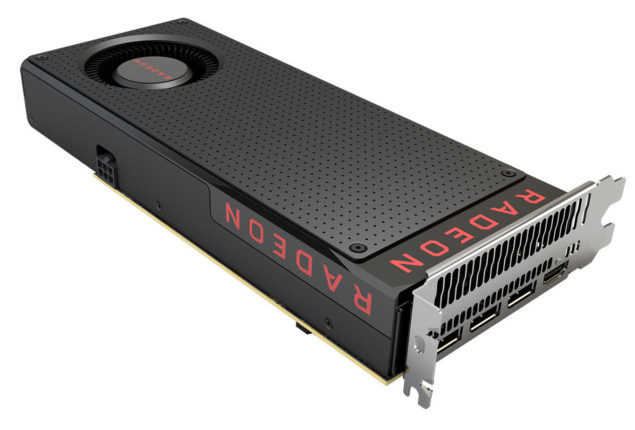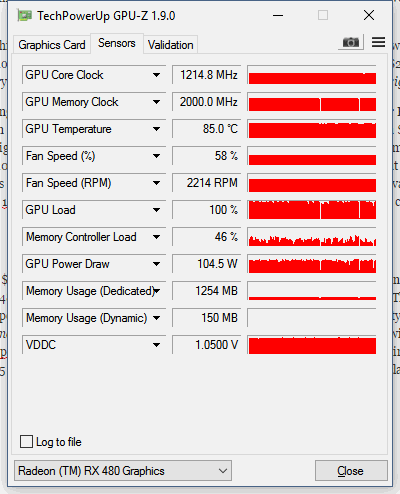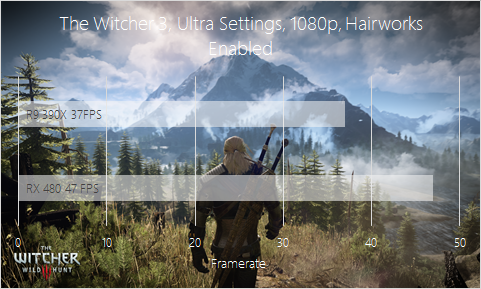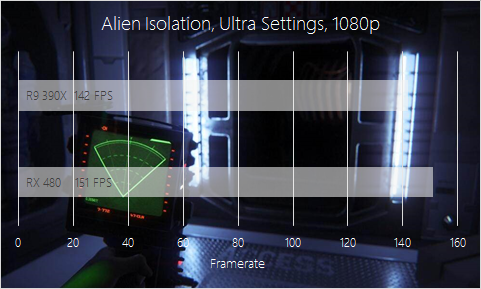
After three straight years of rebadges, refreshes, and general clambering up and down the same price verticals, AMD finally outed their next generation Polaris architecture earlier this year. The flagship Polaris 10 card—the RX 480—might not be a Titan-killer, but in many ways, it’s a far more important play than Nvidia’s ultra-luxury $1,200 status statement. Vast amounts of raw graphics horsepower is nothing particularly new, if you’re willing to dish out big bucks. As far back as 2011, you could’ve gotten yourself a two-way SLI config of the elusive GTX 580 3 GB variant. Apart from the titanic power requirements, that’s still plenty to net you a great 1080p/60 FPS experience this side of the Paleolithic.
No, what’s special about the RX 480 is that it builds on technological progress–the shift to the 14nm process primarily–to offer unprecedented levels of graphics performance at the $200 pricepoint. Polaris’ key selling point is straightforward: It offers more for less. With the move to 14nm, AMD can squeeze more transistors into substantially less space. The direct consequence can be seen in Polaris 10’s diminutive die size: At a mere 220 mm2, it’s half the size of Hawaii/Grenada at 438mm2. The 290X was the high watermark for a very different AMD from the AMD of today: A company that fought Nvidia tooth and nail to somehow deliver better price/performance in every bracket. But the limited R&D budget and the several years of running under loss have taken their toll. AMD today doesn’t have the luxury to bring the fastest, sexiest product to the market. Instead, they’ve opted pragmatically to make an impact in the mainstream segment, to deliver high-end graphics horsepower to everyday gamers.
In many ways, the 480 is the inverse of the Hawaii-based 290X. The 480 positively sips power while it was an open secret that the 290X’s monstrous power requirements were understated so that AMD could sell it as a 250W part. The 480 runs cool and quiet while the 290X touched 95 degrees Celsius during normal operation and sounded like a jet turbine. And in terms of positioning, where the 290X was 2013’s $549 performance king, the RX 480’s $200 price tag puts it very comfortably in midrange territory. It’s a cooler, quieter, lower profile evolution at a much more budget-friendly price-point: what’s not to like? But the discrete graphics market a very different place today than it was in 2013. Where does the RX 480 fit in right now? And crucially, how relevant is it?
Nvidia was the first to out products on the new process node, with the GTX 1080 and 1070 debuting in late May and early June respectively. But Nvidia’s strategy with their Pascal line is fundamentally different from what Team Red’s looking to do with Polaris. Founder’s Edition pricing has effectively meant that both the x70 and x80 lines have received an $80-150 markup in pricing, compared to their Maxwell predecessors. We’re still waiting for a $379 GTX 1070. We don’t expect it to materialize anytime soon.
With the new Titan X, Nvidia’s pushed the pricing boat even further out there, with a very straightforward $200 markup compared to the original Titan X. Between circa $800 GTX 1080 SKUs and this, we can only imagine what 1080 Ti pricings will looks a few months down the road. At $249, the GTX 1060 is far more price-competitive, particularly against the 8 GB variant of the 480, but there’s nothing quite like the $200 4 GB RX 480 in Nvidia’s current product stack. Of course, this is a great time to snap up used GTX 970’s off ebay for even less, but that’s a whole other thing altogether. AMD’s objective with the RX 480 was to increase their TAM (total addressable market.)
While 4K gaming occupies a lot of mindshare, according to Steam, 1080p is still where it’s at for the vast majority of PC gamers, and that’s unlikely to change for the next 3-5 years. Because most PC gamers are, in a sense, bottlenecked by their monitor resolution, the need is for a competitive card that delivers at 1080p/60, and the RX 480 does just that. Moreover, while we’re still a bit cagey about VR’s immediate prospects, the 480 is enough to power a great HTC Vive/Oculus Rift experience. But is the 480 the card you want? Without further ado, let’s get on with the review.
Initial Impressions:
The folks over at AMD sent us a reference 8 GB RX 480 to test. The official pricing for the card is $229, but 0n account of availability issues, actual prices for the 8 GB variant start at $239, dangerously close to GTX 1060 prices. Our review unit didn’t ship with the retail box, but it sure was packed with a lot of awesome bubblewrap. Yay bubblewrap! Moving on to the card itself, our 480 was wonderfully utilitarian–no glowing red lights or pointy bits at all. The textured matte black finish lent the card a premium feel in hand.
Thermals, Noise, and PowerTune:
The single blower fan, wasn’t exactly whisper-quiet, but the default thermal/acoustic profile tended to prefer lower RPM, quieter fan operation over thermals: While the fan operated in the very tolerable vicinity of 2000 RPM, temps climbed worryingly, peaking at 91 degrees. On the plus side, the new Wattman software that comes bundled with the driver offers a good deal of granular control over fan speed, temps, and voltages and clockspeed. A slightly more aggressive custom fan profile, with the speed upped a notch to around 2400 RPM is enough to keep the card’s temps in the mid 80s, while still remaining relatively quiet.
AMD PowerTune is analogous to Nvidia’s GPU boost, regulating clockspeeds to ensure the card stays within predefined temperature and power limits. While the RX 480 has a nominal boost clock of 1266 MHz, we found that, in practice, the card’s core clockspeed tended to fluctuate around 1218 MHz. Fortunately, simply upping the power limit by 15 percent was all it took to get the card running consistently at 1266 MHz, clawing back a decent bit of performance. We benched the card at stock power draw, of course, but we highly recommend feeding the card a bit more power in real-world scenarios.
Benchmarking Methodology:
We ran all benchmarks on the RX 480 and compared these results with collated data for the R9 390X DCUIII OC. We ran all titles at 1080p, the most commonly used resolution by PC gamers per Steam. Where available, MSAA was turned up to 4X, and all other settings were maxed out.
In each game, except for GTA V which provides an intensive built-in benchmark, we picked a specific area in the environment that appeared to be a close match to typical gameplay conditions. For example in The Witcher 3, this location was White Orchard, the starting village.
We ran our RX 480 benches on a testbed running the latest build of Windows 10, on the latest official drivers. The R9 390X data is exactly a year old. This offers an interesting opportunity: Since the Crimson Driver rebrand last November, AMD’s made a concerted effort to deliver consistent and timely driver updates. The accumulated results a year later are telling: despite having 512 fewer shaders and a 33 percent less memory bandwidth, the RX 480 handed in better results at 1080p across the board, compared to the 390X running on the older 15.2 drivers. Of course, the 390X itself has also benefited from this, but the results do seem to indicate a genuine commitment on AMD’s part to improve the quality of their graphics drivers.
We did multiple benchmarking runs per game, and used FRAPS to record framerates before calculating multi-run averages for each game.
Testbed:
- Core i5 4440 at 3.1 GHz
- Gigabyte H81M-D3H Motherboard
- 8 GB of DDR3 RAM at 1666 MHZ
- 4 TB WD Blue SSHD at 7200 RPM
- Coolermaster Thunder 600W PSU
- A 22-inch 1080p Display
- A huge black cabinet
Benchmarking Results: The Witcher 3
The performance uplift compared to our old 390X data set is immediately evident in The Witcher 3. The RX 480 hands in an eminently playable experience with a 47 FPS average, while the 390X averaged 27 percent slower. Apart from driver improvements over time, cumulated Witcher 3 performance updates are also a likely at work here. But whatever combination of factors, AMD hardware showed a marked increase in The Witcher 3 performance since last year and the whole Hairworks controversy. At 47 FPS on average, the game does a good job conveying a “subjective 60” experience. If you must run the game at a consistent 60 FPS update, Hairworks will have to go and foliage visibility range will have to be dropped a notch. Either way, the RX 480 delivers a fantastic Witcher 3 experience going above and beyond the console versions.
Benchmarking Results: Alien: Isolation
Seemingly defying common knowledge that franchise tie-ins are just cash grabs, Alien: Isolation offers a remarkably tense and well-crafted survival horror experience. The visuals are great–particularly the atmospheric lighting, but even better, performance scales admirably on PC. A cross-gen title like Isolation should have no issues running on a card of the 480’s calibre. Unsurprisingly, the RX 480 hands in a 151 FPS average, ahead of the 390X at 142 FPS. Unless you have a high-framerate monitor, all those extra frames are going to waste. Alien: Isolation makes a great use case for VSR (Virtual Super Resolution) downsampling, as both the RX 480 and the 390X have enough performance headroom to downsample from 1440p or higher while maintaining playable framerates.
Benchmarking Results: Grand Theft Auto V
Grand Theft Auto V is the example of how to execute a multiplat. From a technical perspective, GTA V plays to strengths of every platform it appears on: Aggressive LoD scaling and lower-res textures enable the game to hand in a solid 30 FPS experience on the last-gen consoles. The next-gen console versions aren’t a simple up-resing job: Many assets have been built from scratch, with high-poly meshes and hi-res textures factoring in the plentiful amount of headroom offered by the Playstation 4 and Xbox One. The inclusion of a first-person perspective completely changes the gameplay equation, turning GTA V into a kind of urban Far Cry. The PC version is Rockstar’s crowning achievement: a smorgasbord of adjustable settings allows the game to scale any which way you’d like: Want a PS3/Xbox 360 visual experience at 120 Hz? It’s doable. Want a top-end 4K experience going above and beyond the PS4/Xbox One? Go for it.
The intensive PC exclusive features, particularly the increased LoD, make GTA V’s PC benchmark punishing. GTA V is yet another example of what mature drivers can do for AMD hardware. We noted in our earlier 390X review that the 390X struggled with GTA V’s top-end settings, handing in a somewhat choppy 35 FPS update in GTA V’s benchmark. The RX 480 has the advantage, with a 40 FPS average. The performance uplift here isn’t quite as revelatory—thanks to a substantially wider memory interface, the 390X has far more memory bandwidth available to it, meaning that it takes less of a performance hit when enabling hardware antialiasing. Dropping to FXAA results in the RX 480’s framerate increase to a 46 FPS average. If you’re after a better-than-console 60 FPS experience, disabling the PC-exclusive Advanced Settings should suffice.
Benchmarking Results: Doom
With the new low-level APIs—DirectX 12 and Vulkan—here to stay, we benchmarked Doom to get a picture of how the RX 480 will perform in upcoming games. The RX 480’s async compute capabilities—the ability to run compute and graphics loads at the same time, under Vulkan and DX12—has resulted in a tangible performance uplift over OpenGL. When running under Vulkan, we averaged 109 FPS, while this dipped to 83 FPS under OpenGL. This is a profound 25 percent uptick in performance. An interesting caveat about benchmarking Doom: FRAPs hasn’t been updated yet to work in DX12 and Vulkan titles. Because of this, we made use of Present Mon, a rather unwieldy command-line tool. Nevertheless, it’s the only option to bench Vulkan and DX12 games as of now.
Overclocking
With a conservative 150W TDP and a single six-pin power connector, we expected that inadequate power delivery would hold back the RX 480’s overclocking potential, and unfortunately, this seems to be just the case. AMD’s bundled Wattman software is fantastic, offering granular control over everything—voltages, temperature and acoustic limits, and of course core and memory clockspeeds. Due to the said power delivery limitations, the RX 480 has a lot less overclocking headroom than it ought to. As a result, we were only able to push the core clock up by 6 percent, to 1340 MHz. We were able to bump the memory up to 8.6 GHz. The result of the overclock is tangible in The Witcher 3, with a 4 FPS performance uplift, but we were left wanting more.
Conclusion
With their Polaris line, AMD wants to tap into the mainstream market by banking on the shift to the 14nm process node to redefine what’s possible for a $200 card. At $229, the 8 GB version of the RX 480 we’ve reviewed here is slightly pricier, but you get 8 GB of VRAM and slightly higher memory bandwidth for your cash. As a single-card option the 8 GB RX 480 is priced dangerously close to the GTX 1060, which enjoys a comfortable performance advantage in DX11 titles. However the lack of SLI in Nvidia’s budget offering makes the 480 enticing for a degree of futureproofing: Buy a single 480 now, and, when the 1080/60 experience becomes compromised, pop in a second one. Although we reviewed the 8 GB variant here, the 4 GB model offers near-identical performance (plus or minus 1-3 FPS). Priced at $200, the 4 GB RX 480 is the real game-changer.
Rating: 8/10
A review unit was provided by AMD.




















